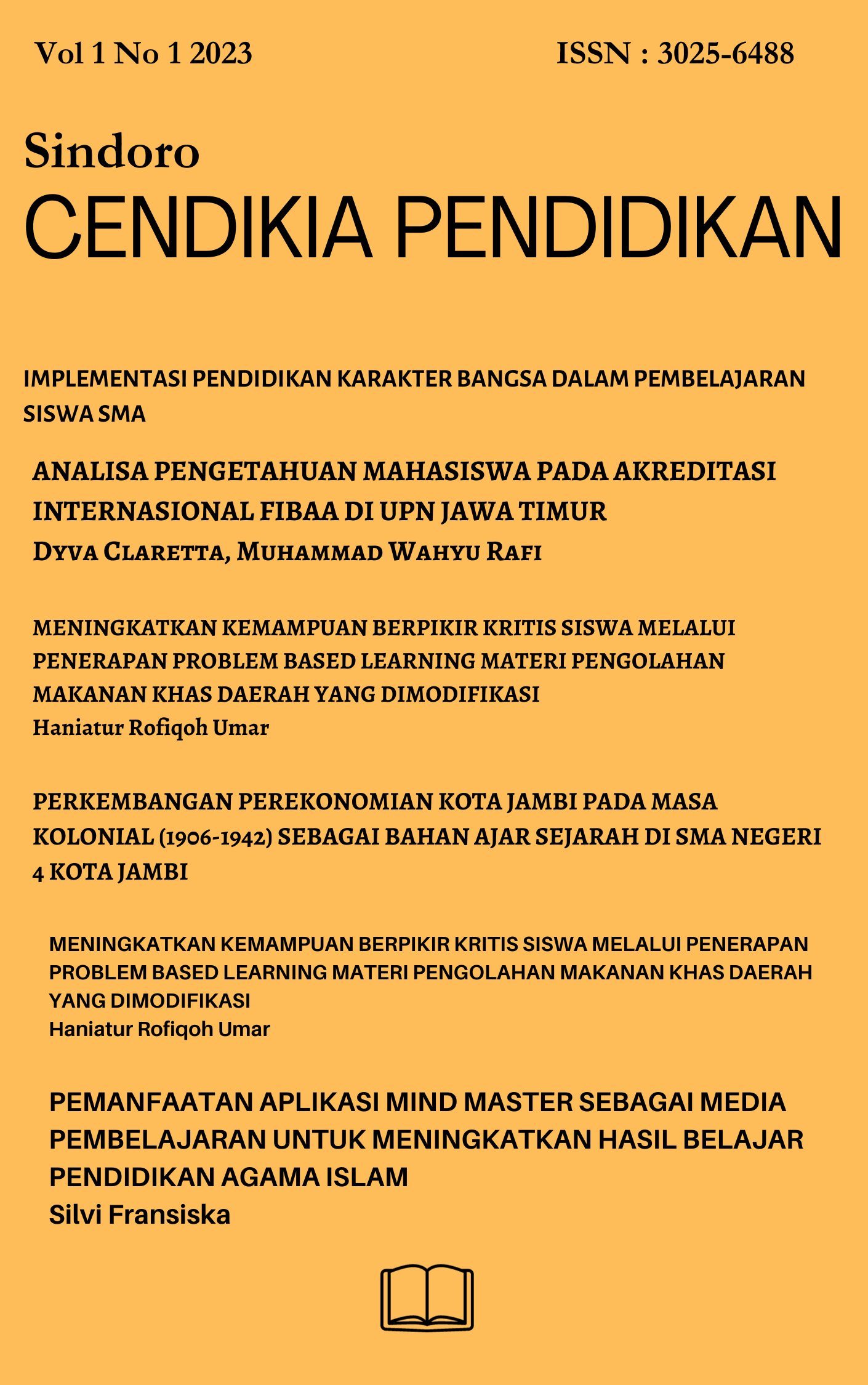LANGUAGE ACQUISITION UNRAVELED: NEW INSIGHTS INTO PSYCHOLINGUISTICS
Main Article Content
Abstract
This journal entry explores the intricate processes of language acquisition through the lens of psycholinguistics, integrating recent advancements in cognitive science, neuroscience, and computational linguistics. It examines traditional theories such as generative grammar, connectionism, and usage-based models, and evaluates their relevance in light of contemporary research. The discussion extends to the impact of age, cognitive abilities, and digital communication on language learning, providing a comprehensive understanding of how humans acquire and process language.
Article Details

This work is licensed under a Creative Commons Attribution-NonCommercial 4.0 International License.
This work is licensed under a Creative Commons Attribution-ShareAlike 4.0 International License.
Authors who publish with this journal agree to the following terms:
- Authors retain copyright and grant the journal right of first publication with the work simultaneously licensed under a Creative Commons Attribution License that allows others to share the work with an acknowledgement of the work's authorship and initial publication in this journal.
- Authors are able to enter into separate, additional contractual arrangements for the non-exclusive distribution of the journal's published version of the work (e.g., post it to an institutional repository or publish it in a book), with an acknowledgement of its initial publication in this journal.
- Authors are permitted and encouraged to post their work online (e.g., in institutional repositories or on their website) prior to and during the submission process, as it can lead to productive exchanges, as well as earlier and greater citation of published work
References
Chomsky, N. (1965). Aspects of the Theory of Syntax. MIT Press.
https://mitpress.mit.edu/9780262530071/aspects-of-the-theory-of-syntax/
Ellis, N. C. (2008). The dynamics of second language emergence: Cycles of language use, language change, and language acquisition. The Modern Language Journal, 92(2), 232-249.
Pinker, S. (1994). The Language Instinct: How the Mind Creates Language. HarperCollins.
http://f.javier.io/rep/books/The-Language-Instinct-How-the-Mind-Creates-Language,-Steven-Pinker.pdf
Tomasello, M. (2003). Constructing a Language: A Usage-Based Theory of Language Acquisition. Harvard University Press.
https://www.hms.harvard.edu/cldp/pub/pdfs/Tomasellobookreview.pdf
MacWhinney, B. (2015). Introduction to the special issue on computational modeling in psycholinguistics. Cognitive Science, 39(3), 499–500.
https://www.lrdc.pitt.edu/schunn/papers/Schunn&Gray02_CSRj.pdf
Pulvermüller, F. (2018). Neurobiological mechanisms for semantic feature extraction and conceptual flexibility. Topics in Cognitive Science, 10(3), 590–614.
Dehaene, S. (2020). How We Learn: Why Brains Learn Better Than Any Machine... for Now. Viking.
Goldberg, A. E. (2006). Constructions at Work: The Nature of Generalization in Language. Oxford University Press.
Kuhl, P. K. (2010). Brain mechanisms in early language acquisition. Neuron, 67(5), 713–727.
https://pmc.ncbi.nlm.nih.gov/articles/PMC2947444/
Hulstijn, J. H. (2015). Language Proficiency in Native and Non-native Speakers: Theory and Research. John Benjamins Publishing.
https://pure.uva.nl/ws/files/1492053/104420_Hulstijn_2011_Language_Assessment_Quarterly.pdf
Azieb, S. (2021). The critical period hypothesis in second language acquisition: A review of the literature. International Journal of Research in Humanities and Social Studies, 8(4), 20–26.
Benjamin, C. F., Walshaw, P. D., Hale, K., Gaillard, W. D., Baxter, L. C., Berl, M. M., Polczynska, M., Noble, S., Alkawadri, R., & Hirsch, L. J. (2017). Presurgical language fMRI: Mapping of six critical regions. Human Brain Mapping, 38(8), 4239–4255.
Bialystok, E. (2017). The bilingual adaptation: How minds accommodate experience. Psychological Bulletin, 143(3), 233.
Birdsong, D. (2018). Plasticity, variability and age in second language acquisition and bilingualism. Frontiers in Psychology, 9, 81.
Caldwell-Harris, C. L., & MacWhinney, B. (2023). Age effects in second language acquisition: Expanding the emergentist account. Brain and Language, 241, 105269.
Fló, A., Benjamin, L., Palu, M., & Dehaene-Lambertz, G. (2022). Sleeping neonates track transitional probabilities in speech but only retain the first syllable of words. Scientific Reports, 12(1), 4391.
Fox, R., Corretjer, O., & Webb, K. (2019). Benefits of foreign language learning and bilingualism: An analysis of published empirical research 2012–2019. Foreign Language Annals, 52(4), 699–726.
Greve, W., Koch, M., Rasche, V., & Kersten, K. (2024). Extending the scope of the ‘cognitive advantage’hypothesis: multilingual individuals show higher flexibility of goal adjustment. Journal of Multilingual and Multicultural Development, 45(4), 822–838.
Herbet, G., & Duffau, H. (2020). Revisiting the functional anatomy of the human brain: toward a meta-networking theory of cerebral functions. Physiological Reviews, 100(3), 1181–1228.
Hu, X., Chiu, M. M., Leung, W. M. V., & Yelland, N. (2021). Technology integration for young children during COVID‐19: Towards future online teaching. British Journal of Educational Technology, 52(4), 1513–1537.
Huang, M., Qian, Q., & Zhu, X. (2017). Encoding syntactic knowledge in neural networks for sentiment classification. ACM Transactions on Information Systems (TOIS), 35(3), 1–27.
Kepinska, O., de Rover, M., Caspers, J., & Schiller, N. O. (2018). Connectivity of the hippocampus and Broca’s area during acquisition of a novel grammar. NeuroImage, 165, 1–10.
Kim, Y., & Smith, D. (2017). Pedagogical and technological augmentation of mobile learning for young children interactive learning environments. Interactive Learning Environments, 25(1), 4–16.
Lany, J., Shoaib, A., Thompson, A., & Estes, K. G. (2018). Infant statistical-learning ability is related to real-time language processing. Journal of Child Language, 45(2), 368–391.
Maluch, J. T., & Kempert, S. (2019). Bilingual profiles and third language learning: The effects of the manner of learning, sequence of bilingual acquisition, and language use practices. International Journal of Bilingual Education and Bilingualism.
Romeo, R. R., Leonard, J. A., Robinson, S. T., West, M. R., Mackey, A. P., Rowe, M. L., & Gabrieli, J. D. E. (2018). Beyond the 30-million-word gap: Children’s conversational exposure is associated with language-related brain function. Psychological Science, 29(5), 700–710.
Saffran, J. R., & Kirkham, N. Z. (2018). Infant statistical learning. Annual Review of Psychology, 69(1), 181–203.
Shadiev, R., Hwang, W.-Y., & Huang, Y.-M. (2017). Review of research on mobile language learning in authentic environments. Computer Assisted Language Learning, 30(3–4), 284–303.
Suzuki, Y., & DeKeyser, R. (2017). The interface of explicit and implicit knowledge in a second language: Insights from individual differences in cognitive aptitudes. Language Learning, 67(4), 747–790.
Wei, Z. (2023). Navigating digital learning landscapes: unveiling the interplay between learning behaviors, digital literacy, and educational outcomes. Journal of the Knowledge Economy, 1–31.
Zaccarella, E., Meyer, L., Makuuchi, M., & Friederici, A. D. (2017). Building by syntax: the neural basis of minimal linguistic structures. Cerebral Cortex, 27(1), 411–421.

